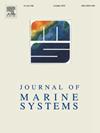Nutrient uptake over Koko Seamount, North Pacific
IF 2.5
3区 地球科学
Q2 GEOSCIENCES, MULTIDISCIPLINARY
引用次数: 0
Abstract
Water temperature and salinity profiles were measured on April 9–10, 2019 above the summit of Koko Seamount (35o15’ N 171o35’ E, with minimal depth of 260 m) and at the slope, with water sampling to measure nutrients concentration, namely dissolved inorganic phosphorus (DIP) and nitrite and nitrate summed as dissolved inorganic nitrogen (DIN). Both DIP and DIN decreased from depth to sea surface proportionally to salinity increasing, with some deviations from this inverse relationship, which were interpreted as the nutrient uptake for the synthesis of new organic matter. These deviations were mostly minor, apparently due to weak density stratification that prevented active phytoplankton growth, but increased up to 0.21 μmol/L for phosphorus and 4.8 μmol/L for nitrogen at 100 m depth above the southern slope and to 0.13 μmol/L and 1.7 μmol/L, respectively, at the summit of seamount. In the first case, the uptake was presumably caused by photosynthesis in the upward flow that transferred nutrient-rich water into the photic layer and simultaneously retained phytoplankton cells in this layer. In the second case, the nutrients were consumed by phytoplankton which were sunk to the lower part of the thick mixed layer but still had sufficient light for photosynthesis at the top of the seamount. The arrangement and characteristics of these productive areas do not contradict to the Taylor column hypothesis that a stream induces an anticyclonic eddy over a seamount with downward flow in the centre and compensating upward flows at the periphery, although such water structure is not observed in the fields of temperature and salinity, possibly because of strong vertical mixing. The N:P ratio in utilized nutrients was inclined to greater nitrogen uptake in the first case and greater phosphorus uptake in the second case, relative to the Redfield ratio. As a result, the DIN:DIP ratio in water decreased above the southern slope and increased above the eastern slope located near the summit, downstream of the Kuroshio Extension. These results approve the thesis on heightened bioproductivity of seamounts and explain one of its possible mechanism.
北太平洋科科海山的营养吸收
2019年4月9日至10日,在科科海山峰顶(北纬35o15′,东经171035′,最小深度260 m)和坡面测量了水温和盐度剖面,并取样测量了营养物浓度,即溶解无机磷(DIP)、亚硝酸盐和硝酸盐(统称为溶解无机氮(DIN))。DIP和DIN随盐度的增加而从深度到海面呈一定比例下降,但与这种反比关系存在一定偏差,这可以解释为新有机质合成的养分吸收。这些偏差大多较小,显然是由于密度分层较弱,阻碍了浮游植物的活跃生长,但在南坡以上100 m深度,磷和氮的偏差分别增加到0.21 μmol/L和4.8 μmol/L,在海山顶部分别增加到0.13 μmol/L和1.7 μmol/L。在第一种情况下,摄取可能是由向上流动的光合作用引起的,这种光合作用将富含营养的水转移到光层,同时将浮游植物细胞保留在这一层。在第二种情况下,营养物被沉到厚混合层下部的浮游植物消耗,但在海山顶部仍有足够的光进行光合作用。这些产气区的排列和特征与泰勒柱假说并不矛盾,泰勒柱假说认为,一股水流在海山上诱发了一个反气旋涡旋,中心向下流动,外围补偿向上流动,尽管这种水结构在温度和盐度场中没有观察到,可能是因为强烈的垂直混合。相对于Redfield比值,利用养分的N:P比值在第一种情况下更倾向于氮吸收,在第二种情况下更倾向于磷吸收。因此,在靠近黑潮延伸下游峰顶的东坡上,水的DIN:DIP比在南坡上方减小,而在东坡上方增大。这些结果证实了海山生物生产力提高的理论,并解释了其可能的机制之一。
本文章由计算机程序翻译,如有差异,请以英文原文为准。
求助全文
约1分钟内获得全文
求助全文
来源期刊

Journal of Marine Systems
地学-地球科学综合
CiteScore
6.20
自引率
3.60%
发文量
81
审稿时长
6 months
期刊介绍:
The Journal of Marine Systems provides a medium for interdisciplinary exchange between physical, chemical and biological oceanographers and marine geologists. The journal welcomes original research papers and review articles. Preference will be given to interdisciplinary approaches to marine systems.
 求助内容:
求助内容: 应助结果提醒方式:
应助结果提醒方式:


